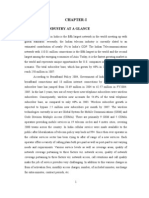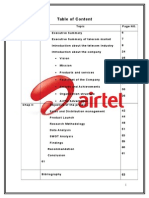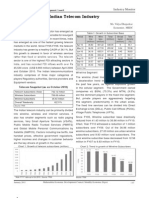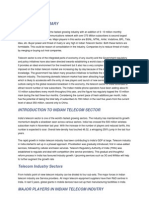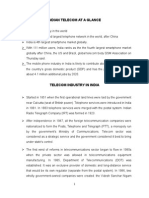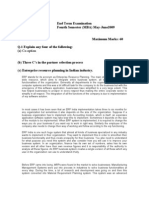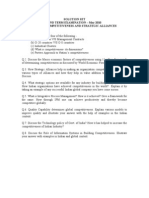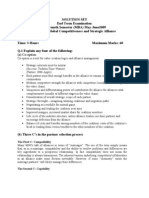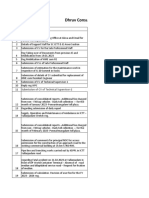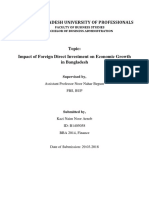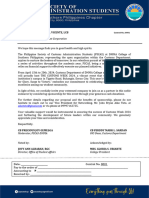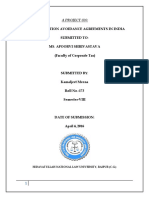Telecom Sector
By:VIKRANT
�Indian Telecom Sector Overview
Indian Telecom Industry
In recent years, the Indian telecom industry has witnessed phenomenal growth. A conducive business environment, favourable demographic outlook and the political stability enjoyed by the country have contributed to the growth of the industry. India achieved the distinction of having the world's lowest call rates (23 US cents), the fastest sale of million mobile phones (1 week) & the world's cheapest mobile handset (USD 20). Indian Telecom Industry Facts
One of the fastest growing cellular markets in the world in terms of number of subscriber additions, 19.35 million in 3 months (April to June 2007) Expected to reach total subscriber base of about 800 million by 2013 (i.e., more than one phone for every individual) Total telecom subscribers 225.21 million (June 2007) Tele density 19.86 percent (June 2007) Number of new mobile subscribers added every month 7.34 million (June 2007) ARPU(avg. revenue/unit) for GSM(2007) USD 6.6 per month Telecom equipment market USD 17,100 million (200607) Handset market USD 4,750 million (200607)
Annual growth rate of the telecom subscribers 57 percent (200708)
More GSM subscribers than fixed-line subscribers
�Number of mobile subscriber will propel the total subscriber base to 600 million by 2012
The telecom subscriber base has witnessed an explosive growth; the additions in the 2011 registered a growth of approximately 47 percent over the previous years. The subscriber base registered a CAGR of 40.4 percent for 200405 to 200809.
Market Share* of Wireless** Operators (As of June 2007)
The state-owned BSNL was the second largest service provider after Bharti Airtel (23 percent) in the Indian wireless telecom market with a market share of approximately 19 percent for the year ending March 2010.
* In terms of Subscriber Base
** Includes GSM, CDMA and WLL-F services
�Indian telecom handset market booming along with mobile services industry
The Indian handset market grew at a phenomenal rate in 2006 with the sale of approximately 3035 million handsets. It is estimated that by 2012, sales of mobile handsets will reach 180 million units.
Competitive pricing has triggered the growth of coloured handsets, which accounted for 65 percent of the market in 2006; whereas, the share of monochrome handsets has declined to 35 percent.
Mobile phones are available at prices as low as USD 1525.
Market Share of GSM and CDMA Handset Manufacturers: 200607
The CDMA category is growing faster than the GSM category. It captured 25 percent of the market volume in 200607 as against a 20.5 percent share in the previous years.
Overall, Nokia has a market share of 53 percent; it dominates the GSM mobile handsets with a market share of approximately 73 percent.
LG dominates in the CDMA handsets market with a market share of 60 percent.
�Regulatory Framework provides level playing field for all operators
The Department of telecommunications (Government of India) is the main governing body for the industry. Telephone Regulatory Authority of India (TRAI) assists the Government of India (GoI) to take timely decisions and introduce new technologies in the country.
Indian Telecom Industry Framework
Indian Government Bodies
Independent Bodies
They formulate various policies and pass laws to regulate the telecom industry in India.
They undertake various research activities and monitor the quality of service provided in the Indian telecom industry. They also provide various recommendations to improve the status of telecom operations in India.
Telecom Regulatory Authority of India (TRAI)
Wireless Planning and Coordination (WPC)
Handles spectrum allocation and management DoT Licensee and frequency management for telecom Exclusive policy making body of DoT
Independent regulatory body
Department of Telecommunications
Telecom Disputes Settlement and Appellate Tribunal (TDSAT)
Telecom disputes settlement body
Telecom Commission
Group on Telecom and IT (GoT-IT)
Handles issues of the telecom industry
�Major Players in different segments of Indian telecom industry
Basic Services Operators
BSNL Airtel MTNL
MOBILE SERVICES
GSM Services Operators
Reliance
Vodafone Idea
TTSL Reliance BSNL
Internet Services Operators
BSNL MTNL Reliance
CDMA Services Operators
Reliance
TTSL TTSL
BSNL
Airtel
MTNL Mahanagar Telecom Nigam Ltd. BSNL Bharat Sanchar Nigam Ltd.
TTSL Tata Teleservices Ltd.
�India presents a host of opportunities for telecom companies
To reduce their network deployment costs, many service providers are considering
Virtual Private Network is a private data network that
provides connectivity within closed user groups via public telecommunication infrastructure. Competition is likely to heat up in the VPN segment as DoT has relaxed the norms for private players.
infrastructure sharing offers the following advantages:
Improved service quality Increased affordability for customers Faster roll out of services in rural and remote areas Significant reduction in initial set up costs Increased environmental aesthetics Lower operating costs for service providers
Enterprise Telecom Services includes key services, such
as voice over Internet protocol (VoIP), dedicated telecom communication systems, IT infrastructure enabled unified communication services, etc. Telecom service providers are increasingly targeting enterprises by providing dedicated services and is expected to witness major developments in near future.
Managed services is another segment that is attracting telecom companies. On
account of the rapidly growing subscriber base, service providers find it difficult to manage their infrastructure and network management operations. In such cases, they completely or partially outsource their infrastructure or network management operations.
�Value-Added Services and Rural Telephony holds large market potential in India
Value-Added Services in India (200910)
The VAS industry was worth USD 632 million in 200910. The industry is estimated to grow by 60 percent in 2011 12 and become an USD 1,011 million.
The VAS industry is currently focussing on the entertainment sector, such as the film industry, cricket, location information(GPS) and mobile transactions.
Rural Telephony
As the government targets to increase rural teledensity from 5 percent to 25 percent by 2012, rural telephony will require major investments. This segment will boost the demand for telecom services, equipment, Internet services and other value-added services; thereby, offering great market opportunities for telecom players.
�India: An Ideal Destination for Investments in Telecom Sector
Skilled and competitive labour force Fifth largest telecom network in the world; second largest among the emerging economies after China On an average, about 67 million new users added per month, making India the worlds fastest growing wireless services market Liberal Foreign Investment RegimeFDI limit increased from 49 percent to 74 percent; the rural telecom equipment market is also open to large investments India is among the countries offering the highest rates of return on investment The large untapped potential in Indias rural markets1.9 percent teledensity in rural markets as compared to the national level of 18 percent Expected to become the second largest telecom market by 2013 The government promoting telecom manufacturing by providing tax benefits. Fully repatriable dividend income and capital invested in telecom equipment manufacturing
�Challenges
No. of operators are increasing per circle: hence more competition Cost is very high in rural areas Infrastructure readiness in rural areas Availability of Contents in local language Availability of Contents for Rural Population International Bandwidth is costly Telecom Manufacturing in India
�Growth in Telecom Sector Network expansion
250 million in 2007 700 million by 2013
Rural connectivity
100 million in 2010 300 million by 2013
Broadband
20 million broadband connections and 60 million internet connections provided in 2011 Broadband connections to provide on demand across the country by 2012
�THANK YOU!!














